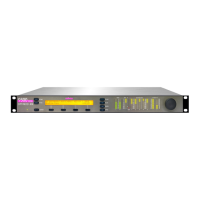OPTIMOD-AM DIGITAL INTRODUCTION
1-5
Factory Presets
The Factory Presets are our “factory recommended settings” for various program
formats or types. The description indicates the processing structure and the type of
processing. Each Factory Preset on the Preset list is really a library of more than 20
separate presets, selected by navigating to M
ODIFY PROCESSING > > BASIC CONTROLS >
LESS-MORE and using the LESS-MORE control to adjust OPTIMOD-AM for less or more
processing. The factory presets are listed and described on page 3-13.
Factory Presets are stored in OPTIMOD-AM’
s non-volatile memory and cannot be
erased. You can change the settings of a Factory Preset, but you must then store
those settings as a User Preset, which you are free to name as you wish. The Factory
Preset remains unchanged.
User Presets
User Presets permit you to change a Factory Preset to suit your requirements and
then store those changes.
You can store more than 100 User Presets, limited only by available memory in your
9300 (which will vary depending on the version of your 9300’s software). You can
give your preset a name up to 18 characters long.
User Presets cannot be created from scratch. You must always start by recalling a
Factory Preset. Make the changes, and then store your modified preset as a User
Preset. You can also recall a previously created user preset, modify it, and save it
again, either overwriting the old version or saving under a new name. In all cases,
the original Factory Preset remains for you to return to if you wish.
User Presets are stored in non-volatile memory that does not require battery back-
up. To Create or Save a User Preset on page 3-12 has more about User Presets.
Input/Output Configuration
OPTIMOD-AM simultaneously accommodates:
A digital AES3 left/right input and an AES3 mono output.
A stereo analog left/right input and two mono outputs.
Digital AES3 Input/Output
The digital input and output conform to the professional AES3 standard. They have
sample rate converters to allow operation at 32, 44.1, 48, 88.2, and 96 kHz sample
frequency.

